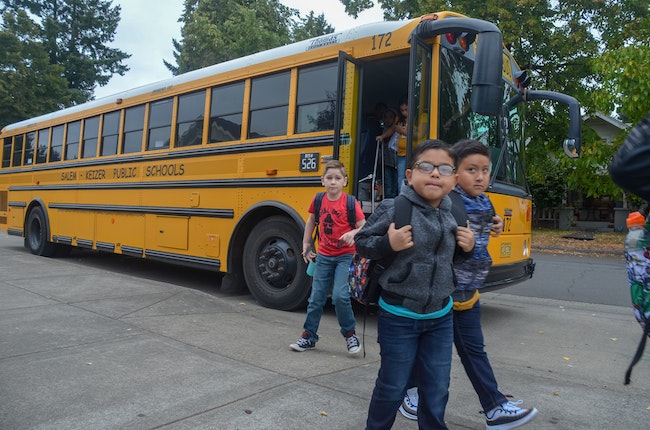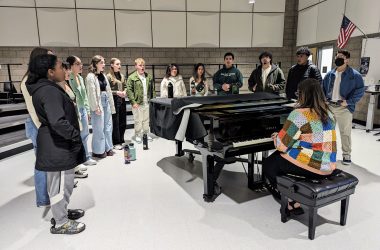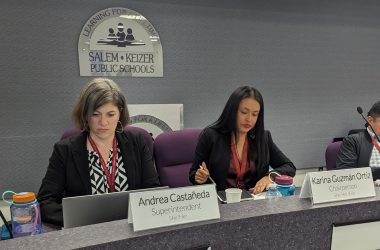 Students get off the bus for the first day of school at Bush Elementary. (Rachel Alexander/Salem Reporter)
Students get off the bus for the first day of school at Bush Elementary. (Rachel Alexander/Salem Reporter)
Salem schools can resume in-person classes in the fall, but students should expect to see smaller classes, bus drivers wearing masks and logs of contacts to aid in tracing any outbreaks of the coronavirus.
State guidelines, released Wednesday, offer a first glance at how schooling could change for 41,000 Salem-Keizer students in the fall.
They make clear that while many students will be in a physical classroom come September, education is unlikely to resemble anything that look place before the pandemic began.
“Flexible” is the go-to word for Salem-Keizer administrators, who are planning to rely largely on in-person classes in the fall while also giving families the option to continue schooling online.
“Our goal is to be as flexible and provide as many options as we can,” Superintendent Christy Perry said.
The district has just 60 days to devise complex plans. The Salem-Keizer School Board must review the plan by Aug. 15 and then open it to community comment.
District leaders created four teams earlier this spring to plan for possible scenarios in the fall, including how a school can quickly move between in-person classes and remote instruction if there’s a COVID-19 outbreak in a particular class or grade, assistant superintendent Kraig Sproles said.
The state guidelines, from the Oregon Department of Education and Oregon Health Authority, allow districts to choose between on-site classes, distance learning or a hybrid of the two, but must meet detailed health requirements to return to the classroom.
“Physical distancing and hygiene are the best tools we have to prevent the spread and every prevention tool we remove increases the opportunity for transmission of the disease. However, we have time to ready our schools to provide in-person instruction in ways that employ the prevention tools we know work,” the guidelines read.
Those include allocating at least 35 square feet of space per person in classrooms, a requirement which will drastically shrink the number of students who can be in class together.
Perry acknowledged crowded Salem-Keizer high schools would be especially challenged to meet some health requirements.
Schools are also encouraged to keep students in smaller groups, called cohorts, that don’t change day-to-day, minimizing the number of people each student is in close contact with.
Keeping students six feet apart where possible is among the goals, and schools are encouraged to change building schedules to allow for greater distancing. School lunches may be eaten in classrooms, and recess will be staggered between cohorts of students, with playground equipment sanitized in between.
Rather than moving students from classroom to classroom, teachers may rotate between classrooms over the course of a day.
Some activities, like science laboratories, career technical education classes, music, theater and PE have additional risks for disease spread. The guidelines do not require schools to cancel those activities, but suggest schools should consider alternatives where possible to minimize risk, including holding some portions of those classes outside.
Students who are at high risk of falling seriously ill if infected with the coronavirus must be considered in local planning, with administrators and school nurses working to address individual student needs.
Students who do attend school in person can expect health screenings upon entering the building. Some school workers, including cafeteria employees and bus drivers, must wear masks, while others are encouraged to do so.
Teachers will also be responsible for educating students about hygiene like hand-washing and avoiding physical contact, but should not punish students who seek high-fives or fist bumps or otherwise fail to adapt quickly.
“When students falter in adhering to the new operating procedures, center grace and patience and reteach the expectation. Never implement consequences that deny access to instruction as a result of these challenges,” the guidelines say.
SUPPORT SALEM REPORTER’S JOURNALISM – A monthly subscription starts at $5. Go HERE. Or contribute to keep our reporters and photographers on duty. Go HERE. Checks can be sent: Salem Reporter, 2925 River Rd S #280 Salem OR 97302. Your support matters.
Contact reporter Rachel Alexander: [email protected] or 503-575-1241.

Rachel Alexander is Salem Reporter’s managing editor. She joined Salem Reporter when it was founded in 2018 and covers city news, education, nonprofits and a little bit of everything else. She’s been a journalist in Oregon and Washington for a decade. Outside of work, she’s a skater and board member with Salem’s Cherry City Roller Derby and can often be found with her nose buried in a book.









